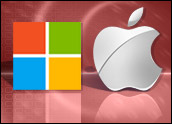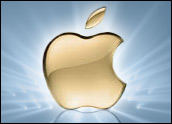
During Apple’s WWDC keynote event last week, it became exceedinglyclear that we won’t be seeing a converged iPad/MacBook device anytimesoon.
Unlike Microsoft, with its Surface Pro 3 effort, Apple doesn’t seem atall interested in forcing iOS and OS X into asingle unified operating system. In fact, Apple doesn’t seem to beinterested in making OS X touch-based or touch-enabled. Nor doesit appear to be working too hard to turn the iPad into a multitasking,laptop-replacing workhorse that resembles anything like the MicrosoftSurface Pro 3.
The two companies have two very different marketing jobs ontheir hands, one of which seems to be working and the other of whichseems to be fading — despite it’s being about a product that by all rights andmeasures seems to be what people say they actually want.
That, it turns out, might be the key difference in the success ofthe two companies. Microsoft seems to be reacting to this grand ideathat people want a converged tablet and laptop that offers the best ofboth worlds — that can do everything. Instead of buying alaptop and a tablet and trying to coordinate the use of two differentdevices, why not have just one?
Why not pound the keys and work the mouse all day long withspreadsheets and email — and then just rip off the keyboard, sitdown in a quiet place, and relax to Game of Thrones on your tabletscreen? Work. Entertainment. Super portable, super versatile. What’snot to love?
Crazy Irony
There’s nothing inherently wrong with the Surface Pro 3 or evenwith Microsoft Windows 8. The hardware is good, and Microsoft’sconverged take on a touch-enabled OS isn’t all bad, either. (And incase you don’t know me, I’m an unabashed Apple fan.)
Check out the marketingpages created by Microsoft to introduce and share the Surfacevision. Microsoft is covering the bases of getting more done, findingentertainment, and using the Surface Pro 3 for creativity. It’s allreasonably personable, directed at “you,” trying to find a way to fitthe Surface into your life.
Yet, somehow Microsoft is saying all the right words, atsupposedly the exact right time, and I’m just not hearing them. I wantto listen, I want to be moved — and heck, I even used to think that Imyself wanted a converged device: that I wanted a touchscreen Macthat could bend into a tablet or an iPad that could snap into akeyboard.
But now I’m not sure if one device to cover converged computing ispsychologically possible to successfully market and sell at all.
Balking at Convergence
For people who work from home, one of the hardest challenges iswalking away from work and returning to your own life — to yourown family, to your own hobbies. If your office is always in yourhome, it’s all too easy to go back to work after hours and get alittle more done. It’s always in front of you, always calling yourname, always demanding attention.
If your work device is also your play device, there is a psychologicalbarrier that can mess with a person’s mind. Work is nagging at play,play is nagging at work, and what is the sign, the signal, thesignifier that tells you to switch your brain to spreadsheets, salesstrategies and supply chain challenges?
Some people get dressed up for special meetings, wear certain shoesfor certain work days. Is it fashion? Not always. Sometimes it’s aboutframing your state of mind to accomplish a certain task. The same goesfor play time. You leave the office, change your clothes, and put on aball cap.
These sorts of things affect lots of humans, and sometimes they areaware of them and sometimes not. I think the Surface Pro is boilingright in the middle of this psychological stew. If I were a smarterhuman, I could sort it out for you. Instead all I can do is stir itaround a bit.
Apple, on the other hand, has managed to avoid these elements ofpsychological confusion. Maybe because Apple is smarter — or maybebecause Apple doesn’t listen to its customers. Instead, Apple buildsthe products it wants to make — and then markets the heck out of theproduct as if it were an extension of a consumer. As Steve Jobsfamously said, “People don’t know what they want until you show it tothem.”
Somehow, either by accident or design, Apple’s seemingly slow plodtoward convergence has resulted in discreet products — phone, tablet,computer — that instead of becoming one are becoming moreconnected. Damn, this somehow makes immediate sense to me.
I can instantly see how I can use apps and features like Handoff tostart working on one device and seamlessly transfer working to anotherdevice. I can start an email on my iPhone… and instead of gettingmad at the little touchscreen keys, just pick up from where I leftoff on my Mac.
I can create a presentation on my Mac and let iCloudlet me update it from my iPad right before I present it at work. A kidcan start a homework assignment at home on a Mac and finish it up atschool in a Web browser. I can leave my iPhone on a charger upstairs(or in my bag) and answer an iPhone call on my Mac.
Notifications, Notes, Reminders and my Calendar start reacting insimilar — but not the same — ways on my iPad, iPhone and Mac, and Iunderstand what each device brings.
The physical nature of the device and operating system provide myoverworked brain clues as to what experience I’ll get — and whatexperience I want in a given moment.
In some ways, the Microsoft Surface Pro 3 is a spork. It’s a spoon anda fork. While a good spork has its place, there’s a reason oursilverware drawers aren’t filled with practical sporks. If I’m eatingsoup, I want a spoon. Can it be as simple as that?
Flying in the Face of Reason
Computers are not sporks. They cost a lot of money. Therefore,how can this idea make sense? For Apple, this doesn’t make intuitivesense: Why force your customers to buy both a high-priced iPad and a MacBook Pro in order to get both tablet and powerful computing abilities? They won’t do it! Except, they are.
Ironically, the buying process for humans is easier tospark when the product is clear: I’m buying a tablet. Furthermore, Ican buy an iPad this year and a MacBook next year, and suddenly I canspread out my purchase activity and get more things thatfunction well within their device identities.
Microsoft, it turns out, might be better served simply by marketingthe Surface Pro 3 as a tablet called the “Surface.” It’s smartphones?SurfacePhone. And laptops? SurfacePC. But Microsoft has the Windowsbranding problem and the third-party business partner problem:Partners want to build their own Windows-based devices. Rock and hardspace.
Sadly, I’ve got to wonder if my Apple goggles have me seeing anApple-made Surface Pro 3 differently. I’m not sure. At first glance,after work, I would like to be able to rip the screen off my MacBookPro and go sit on the couch and tap, flick, zoom and edit somephotos or make some home movies.
Wait, I can do that. I can leave my MacBook Pro on my desk — workat work — and pick up my iPad. Come this fall, all my photos will bestored on iCloud, letting me seamlessly move from device to device andinteract with my life. It’s Apple’s “continuity” message, and italready feels better than trying to use one device for everything.Crazy, I know.












































Forgive me for making a comment that dismisses a lot of careful effort and analysis, but here goes: It’s the keyboard, stupid. 🙂
Keyboards are the primary interface most of us associate with actual work. When I sit down to write an article, edit a spreadsheet, send a volley of emails, etc., I do so at a keyboard. That’s what I started using back in 1984, and it’s been generally excellent for my purposes since then.
Until someone either a) figures out how to build a real functioning keyboard into a tablet or b) figures out how to get millions and millions of people over their keyboard addiction, the convergence of laptop, tablet, and phone can’t take place.
And yes, I know the Surface has a keyboard in the cover. I’ve tried it and don’t like it.
The unification of disparate elements is the key here. It’s one thing to integrate multiple functions into a single device, as so many manufacturers have done, but it is not likely that there will ever be "one device to rule them all."
The fact that one can create hybrids (i.e., phablets on the one side and combo-tablet/laptops on the other) is one thing, but when you consider the upcoming ubiquity of wearables, in-car systems and in-home systems and who knows how many more devices, I’d say the notion of creating and emphasizing continuity from one device to another as Apple is doing is so much more practical and far-reaching.
For those that are experienced and familiar with particular operating systems, more power to you, but I would argue that this familiarity and not simply "preference" may cloud your vision of the future.
"Metro for play" . . . great point. I’m actually hoping to see Microsoft make some inroads in terms of sales this year. Still really curious to see how it shakes out, partially because Microsoft has a decent product now . . . and yet, that may not be enough for mass consumer adoption. I still find that wild. By all measures, the Surface Pro 3 _should_ take off . . . but broad excitement seems muted. If a mature company regains its mojo, can it also regain its consumer mindshare around the world? Definitely paying attention. . . .
–CM
I think the thing that is often overlooked on tech sites when this sort of discussion comes up is the needs of the average user. Most of us who come to these sites are more likely to be people who might actually need the equivalent of both a Mac Pro and a tablet. Most users probably only need one or the other. My guess is that the iPad is successful because it meets the limited needs of many users and does it in a convenient package for a relatively reasonable price. Whereas the Surface Pro is a 5 pound sledge hammer. Sure, you could drive a nail to hang a picture on with it, but it’s overkill and the 17 oz. wooden hammer will do the job just as well for less. Whereas the jobs that call for a 5 pound sledge are limited.
I have never seen anyone using an ipad with a keyboard. It’s true that keyboards for it exist… but they don’t seem to be a hot item for most people, so I think your perception of how people actually use their ipads might be off.
I have however seen people using the iPad to capture pictures… and I agree that it looks pretty silly.
The ipad is great at what it’s meant for. Consumption of media, games, light email, social networking, etc. It’s also possible to use it for some content generation, though I do not think it’s ideal for that, nor was it meant to be ideal for that.
Apple has also been involved in a marketing deal with colleges to push an iPad agenda. Many colleges now use e-text books and apps in conjunction with the iPad, with a "special" finance rate (usually free to the student)…
the agenda is purposely compatible with Apple products, and is mostly compatible with PC’s.
So just going by numbers is not an accurate measure what’s going on… I still use my PC for class and I work through the apps.
I do not like the majority of Apple products… (however, the iPod touch makes for a nice MP3 player (but not M4A))…
I lived through the nutroll of the PC development of the late 1970’s and early 1980’s where there were multiple OS’s out there, and it was awful. This is how I view Apple’s OS, the one that failed as a "PC" alternative. Yes, Microsoft has some OS issues, but at least it is the industry standard, and everybody is familiar with it.
This trend in iPad style computing reminds me of the early cell phone era, with the monster sized cellphones of yesteryear.
To really make the iPads useful, many have bought an accompanying keyboard, which, really, just turned the iPad into a limited, mini-laptop… So now what’s point??? And using the iPad as a camera or a video capturing device makes the user look absolutely ridiculous…
It appears that a product was made without a purpose, and now there are needy applications being created to make it purposeful… which is logically backwards… there should have been a need, then a product created to fulfill the need…
I have been a Windows user since 3.1 and Android user since 2.2 and it is very likely our vision of things are clouded by our technology preferences. For example, my wife switched from Android to iOS when the iPhone 5s came out and frankly, I don’t get it. I find it hard to navigate, it feels claustrophobic, and just not customizable enough for me. Last night, I couldn’t set an alarm on it because I couldn’t locate a Clock app – I gave up after 5 minutes and just dragged my butt off the bed to locate my Android phone in the living room, set the alarm, and get back to bed – all under 5minutes.
Anyways, this psychological barrier you mention is non-existent with the Surface. Why? The 2 UIs. You have the desktop for work, you have the Metro for play. With a touch of a button, you can switch between the 2 – even more seamless. Microsoft’s approach has enabled me to carry just 2 devices – the tablet/laptop hybrid and my phone – without sacrificing my ability to produce and have fun.
The Walkman, portable DVD player, the calculator, the GPS all used to be separate devices but look where we are now. The technology to make high-quality fanless tablet hybrids is here now and this I believe will make the consumer (Enterprise already knows this) rethink their reasons for carrying multiple devices very soon.